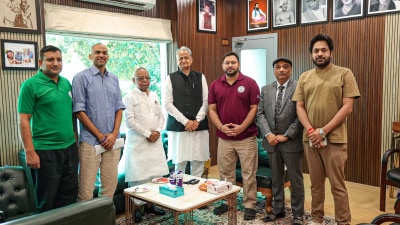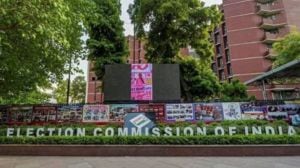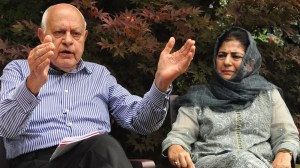
Preliminary Examination: Current events of national importance
Mains Examination: General Studies-II, III: Government policies and interventions, Disaster Management.
Story continues below this ad
What’s the ongoing story: At least 18 people were killed and several others injured in a stampede at the New Delhi Railway Station late Saturday evening. From the initial 15 persons feared to be dead, the toll rose to 18 as of Sunday morning.
Key Points to Ponder:
• What is a stampede?
• What are the factors leading to stampedes?
• What role did the ‘rumour’ play in stampedes?
• “A rumour can kill thousands than a bullet can”-Decode the quote with respect to stampede and rumour
• What are the NDMA guidelines for crowd management in India?
• What should be done for effective crowd management and preventing stampedes?
Key Takeaways:
Story continues below this ad
• Delhi police released a list of the 18 deceased on Sunday morning. The police have launched an investigation into the incident and officials said that they will be scanning the CCTV footage from the spot to know what transpired before the chaos erupted.
• In an official statement, the Railways said, “An unprecedented rush situation developed today at approximately 9:30 pm at New Delhi Railway Station near platforms 13 and 14. Due to the sudden surge in passengers, some individuals fainted, which led to rumours of a stampede-like situation, causing panic among travellers. The situation was later brought under control by easing the congestion.”
Do You Know:
• Wenguo Weng and others define a stampede as “an impulsive mass movement of a crowd that often results in injuries and deaths” (“Review of analyses on crowd-gathering risk and its evaluation methods”, 2023).
• According to Illiyas and others, “Stampede is the surge of individuals in a crowd, in response to a perceived danger or loss of physical space. It often disrupts the orderly movement of crowds resulting in irrational and dangerous movement for self-protection leading to injuries and fatalities”.
Story continues below this ad
• K M Ngai and others classify two types of stampedes on the basis of movement — unidirectional or turbulent (“Human Stampedes: A Systematic Review of Historical and Peer-Reviewed Sources”, 2009). Unidirectional stampede events may occur when a crowd moving in the same direction encounters a sudden positive or negative change in force which alters its movement. A positive force can be a “sudden stop” situation like a bottleneck and blocked exit, whereas a negative force would be something like a broken barrier or column which sends a group of people tumbling. Turbulent stampede events can occur in situations with uncontrolled crowds, induced panic, or crowds merging from numerous directions.
• Crowd management is a crucial tool for ensuring the safety of citizens during various types of mass gatherings. Unfortunately, stampedes still occur. According to nidm.gov.in, such unfortunate events happen due to a lack of (i) understanding of crowd behaviour, (ii) coordination, (iii) clear roles & responsibilities of various stakeholders, and (iv) proper planning on the part of organizers.
Other Important Articles Covering the same topic:
📍UPSC Issue at a Glance | How to prevent stampedes at mass gatherings — 4 Key Questions You Must Know for Prelims and Mains
UPSC Previous Year Mains Question Covering similar theme:
📍Discuss the recent measures initiated in disaster management by the Government of India departing from the earlier reactive approach. (UPSC CSE 2020)
Story continues below this ad
📍Crowd management is an important tool for safety of citizens especially at religious places. Unfortunately crowd disasters still happen. What are the major reasons behind such disasters. Suggest strategies to avoid crowd disasters.
Syllabus:
Preliminary Examination: Current events of national and international importance.
Main Examination: General Studies-I, II: Effects of globalization on Indian society, Effect of policies and politics of developed and developing countries on India’s interests, Indian diaspora.
What’s the ongoing story: Ten days after the United States deported 104 illegal Indian immigrants in a military plane, 119 more illegal immigrants – the second batch under the current US administration – landed in Amritsar at close to midnight on Saturday. Sources said a third batch of another 157 deportees is expected to land in Amritsar on Sunday night.
Key Points to Ponder:
• Who are migrants?
• Who are illegal immigrants?
• What is the ‘Dunki network’?
• What are the push and pull factors of migration?
Story continues below this ad
• What are the reasons behind illegal immigration by Indian migrants to countries like the United States?
• Read about the issue of H1-B visa.
• Critically assess the role of international law and human rights considerations in the deportation of illegal immigrants.
• How should countries balance their sovereign right to enforce immigration laws with their obligations under international human rights frameworks?
Key Takeaways:
• During a joint press conference with Trump at the White House on Thursday, Prime Minister Narendra Modi had said that India was “fully prepared” to take back any verified Indian who was in the US illegally.

Story continues below this ad
• He said this issue was not limited to India alone, and the “bigger fight” was on ending this “ecosystem” which is involved in “human-trafficking”
Do You Know:
• The Trump administration has identified about 20,000 Indian illegal immigrants as part of its mass deportation plan. Indians comprise about 725,000 illegal migrants — the biggest group outside of Central and Latin America.
• “Dunki” or “donkey journey” refers to the long-winding, often dangerous routes that people across the world take to reach the places they want to immigrate to. These difficult journeys are undertaken due to a lack of requisite legal permits or financial resources. The American authorities have deported those who have taken this illegal route to reach America.
Story continues below this ad
 Credit: Express design team
Credit: Express design team
• Deportation is the process of removing a non-citizen from the US for violating immigration law. The US may detain and deport non-citizens who participate in criminal acts, are a threat to public safety; or violate their visa. The foreign national may be held in a detention centre before trial or deportation.
• After the deportation of the illegal migrants from the USA, the Indian government said that it is “seriously considering” enacting a new law, tentatively titled ‘Overseas Mobility (Facilitation and Welfare) Bill, 2024’, to establish an enabling framework which will promote “safe, orderly and regular migration for overseas employment”.
 One of the Dunki route followed to reach USA. It involves crossing Darien Gap connecting Panama and Colombia. (Express)
One of the Dunki route followed to reach USA. It involves crossing Darien Gap connecting Panama and Colombia. (Express)
• Keeping in view the “contemporary global migration dynamics and the needs of Indian citizens”, it says that the committee has over the years underscored the pressing need for a comprehensive legislative overhaul to replace the outdated provisions of the Emigration Act 1983.
Other Important Articles Covering the same topic:
📍Explained: India-US ties and the illegal immigration issue
📍Indian migrants sent back from US: Why Trump is using expensive military planes for deportation
📍How to facilitate safer and more productive migration patterns
UPSC Previous Year Mains Question Covering similar theme:
Story continues below this ad
📍Discuss the changes in the trends of labour migration within and outside India in the last four decades. (UPSC CSE 2015)
EXPRESS NETWORK
Syllabus:
Preliminary Examination: Current events of national and international importance
Mains Examination: General Studies-II: India and its neighbourhood- relations.
What’s the ongoing story: India’s trade equation with Afghanistan has witnessed a shift after the Taliban’s return to power in August 2021, with imports touching a record $642.29 million in 2023-24 and exports slumping to a 16-year low, creating an unusual trade deficit, reveals Ministry of Commerce data.
Key Points to Ponder:
• What is the history of India-Afghanistan relations?
• What are the areas of cooperation and conflict between India and Afghanistan?
• What are the main products imported from and exported to Afghanistan?
• What is the Taliban, and what is its history?
• How has India navigated its relationship with the Taliban since they took power?
• What key factors have prompted India to engage with the Taliban at a higher level?
• Map work: Location of Afghanistan.(Refer Atlas)
Key Takeaways:
• This shift gains significance as New Delhi has initiated its highest-level contact yet with the Taliban regime and the latter too has expressed interest in strengthening political and economic ties with India, calling it a “significant regional and economic power”.
• The recent talks between India’s Foreign Secretary Vikram Misri and Taliban Foreign Minister Amir Khan Muttaqi reportedly focused on expanding trade and leveraging Iran’s Chabahar port, which India has been developing to bypass Pakistan’s Karachi and Gwadar ports.
• According to government data, in 2020-21, before the Taliban takeover, the value of exports to Afghanistan stood at $825.78 million and imports at $509.49 million. India’s exports fell sharply to $554.47 million in 2021-22, $437.05 million in 2022-23 and $355.45 million in 2023-24.
• Before this, the last time India saw a trade deficit ($0.73 million) with Afghanistan was in 2000-01.
• In 2023-24, the top items India imported from Afghanistan were mainly agricultural produce — figs, asafoetida, raisins, apples, garlic, saffron, fennel seeds, almonds, apricots, onions, pomegranates and walnuts. India’s exports to Afghanistan include mainly medicines, vaccines, soybean meal, and garments.
• “India-Afghanistan trade reflects a blend of economic cooperation and strategic priorities, underlining India’s focus on regional stability. Despite Afghanistan’s political challenges and reliance on alternative routes like the Chabahar Port in Iran, trade continues, supported by India’s investments in projects like the Salma Dam and Afghan Parliament. Initiatives like the 2017 air freight corridor and duty waivers on Afghan imports have eased trade and strengthened goodwill through humanitarian aid,” said Ajay Srivastava, founder, Global Trade Research Initiative (GTRI ), a trade research body.
Do You Know:
• Afghanistan’s geopolitical significance goes beyond India and Pakistan. It is a multi-ethnic, landlocked country positioned at the crossroads of Central Asia, the Middle East, and South Asia. This strategic location has historically drawn the interest of major global and regional powers, making Afghanistan a focal point in global politics. Acknowledging Afghanistan’s significance, India has carefully crafted its policy towards the country.
• In the first high-level bilateral engagement with the Taliban regime, Foreign Secretary Vikram Misri met Afghanistan’s acting Foreign Minister Amir Khan Muttaqi in Dubai on 8th January. This meeting was particularly noteworthy, as it involved an Indian official at the level of foreign secretary, a step up from previous engagements, which were conducted by joint secretaries. This change signals an upgrade in official interactions from the Indian government. A statement from the Ministry of External Affairs said the two sides discussed various issues pertaining to bilateral relations as well as regional developments.
• India’s investments in Afghanistan: India has constructed essential infrastructure, including roads, dams, electricity transmission lines, substations, schools, and hospitals in Afghanistan. The value of India’s development assistance is now estimated to exceed $3 billion. Unlike in some other countries where India’s infrastructure projects have struggled to gain traction or have been hindered by local politics, these initiatives have successfully been implemented in Afghanistan.
Other Important Articles Covering the same topic:
📍UPSC Issue at a Glance | India-Taliban Talks: Key Questions You Must Know for Prelims and Mains
Previous year UPSC Prelims Question Covering similar theme:
(1) Consider the following countries: (UPSC CSE 2022)
1. Azerbaijan
2. Kyrgyzstan
3. Tajikistan
4. Turkmenistan
5. Uzbekistan
Which of the above have borders with Afghanistan?
(a) 1, 2 and 5 only
(b) 1, 2, 3 and 4 only
(c) 3, 4 and 5 only
(d) 1, 2, 3, 4 and 5
(2) Consider the following pairs:
1. Chabahar Port: Iran
2. Salma Dam: Aghanistan
3. Kursk: Russia
Which of the pairs given above are correct?
(a) 1 and 2 only
(b) 2 and 3 only
(c) 1 and 3 only
(d) 1, 2 and 3
Previous year UPSC Mains Question Covering similar theme:
The proposed withdrawal of the International Security Assistance Force (ISAF) from Afghanistan in 2014 is fraught with major security implications for the countries of the region. Examine in light of the fact that India is faced with a plethora of challenges and needs to safeguard its own strategic interests. (UPSC CSE 2013)
Syllabus:
Preliminary Examination: Current events of national importance and Rights Issues
Mains Examination: General Studies-II, III: Government policies and interventions, Economic Development
What’s the ongoing story: The RBI defended the collection of financial data of banking users by credit rating companies to prepare credit scores and submitted before the Supreme Court that it was precisely the purpose behind Parliament enacting the Credit Information Companies (Regulation) Act, 2005 and companies do not need consent from the borrowers for this.
Key Points to Ponder:
• What is the Credit Information Companies (Regulation) Act, 2005?
• What are its key provisions?
• Why was the Credit Information Companies Regulation (CICR) Act enacted?
• What is the Reserve Bank of India’s stance on the collection of financial data by Credit Information Companies (CICs)?
• What are the major concerns associated with data collection by CICs and their alleged violation of privacy rights?
• Read about the Indian Cyber Crime Coordination Centre (I4C).
• How does the Indian Cyber Crime Coordination Centre (I4C) plan to address concerns regarding data theft and misuse by fintech companies?
• How does the CICR Act help mitigate risks related to Non-Performing Assets (NPAs) in the banking sector?
Key Takeaways:
• Petitioner Surya Prakash, a Bengaluru-based entrepreneur and educational trainee, had moved the top court accusing the Credit Information Companies (CICs) of “illegally” collecting people’s financial information “by forced consent” and “selling the data to their members”. The plea also accused the CICs of “blatant abuse and violation of right to privacy”.
• The plea also said that the Centre and the RBI have an “unholy and unethical alliance” with the CICs to undermine citizens rights.
• In a separate affidavit, the Indian Cyber Crime Coordination Centre (I4C), under the MHA, said, “in response to the averment made by the petitioner regarding data theft, I4C has requested the nodal officer of cybercrime units in all States/UTs vide letter… dated 14.08.2024 seeking information regarding FIR/case registered against credit information companies and fintech companies. However, the response is awaited.”
• In its counter affidavit on December 23, 2024, the RBI said that the plea raises “baseless, unfounded and speculative issues in complete ignorance of the provisions of the CICR Act and regulations”.
• The RBI said that the law “expressly empowers the credit information companies to collect, store and maintain as well as process the credit information of the borrowers and as such with the enactment of the CICR Act, the requirement of consent from the borrowers has been rendered otiose.”
• On apprehensions that the data might end up in the wrong hands, the affidavit said that under the Act, “every credit information company is bound to provide credit information to its specified user on receipt of a request from him and… the credit information cannot be disclosed by credit information companies to any person other than its specified user.’
Do You Know:
• The RBI said that the CICR Act “was brought in as part of risk mitigating policy of the Government… to arrest accretion of fresh NPAs in the banking sector” and provides “for setting up the CICs for collecting, sharing, processing and collating as well as disseminating the credit information of clients/ borrowers/ prospective borrowers in the manner provided in the CIC (Regulation) Act so as to enable the lenders like banks and other financial institutions to take an informed decision while lending money to borrowers.”
Previous year UPSC Prelims Question Covering similar theme:
(3) Which of the following statements best describes the term ‘Scheme for Sustainable Structuring of Stressed Assets (S4A)’, recently seen in the news? (2017)
(a) It is a procedure for considering ecological costs of developmental schemes formulated by the Government.
(b) It is a scheme of RBI for reworking the financial structure of big corporate entities facing genuine difficulties.
(c) It is a disinvestment plan of the Government regarding Central Public Sector Undertakings.
(d) It is an important provision in ‘The Insolvency and Bankruptcy Code’ recently implemented by the Government.
ECONOMY
Syllabus:
Preliminary Examination: Current events of national and international importance, Economic Development
Mains Examination: General Studies-II, III: Bilateral, regional and global groupings and agreements involving India and/or affecting India’s interests, Effects of liberalisation on the economy, changes in industrial policy and their effects on industrial growth.
What’s the ongoing story: The Bilateral Investment Treaty (BIT) should be handled separately and negotiated standalone from the Free Trade Agreements (FTAs) by specialists with expertise in elements of policymaking such as taxation, Union Finance Minister Nirmala Sitharaman said on Saturday.
Key Points to Ponder:
• What are Free Trade Agreements (FTAs)?
• What role do arbitrators play in BIT disputes?
• What are the concerns associated with international arbitration in the context of BITs?
• What key reforms are proposed in India’s revamp of the 2016 model BIT?
• Which international partners is India currently in talks with for new investment treaties?
• Read about the European Free Trade Association (EFTA)
• How does the investment treaty framework aim to balance national interests with regulatory powers?
Key Takeaways:
• Sitharaman also underlined that before taking up international arbitration, enough time should be given to the contesting parties to go through the available local remedies because that is important for the host country.
• Moving forward, the framework of investment treaties should capture national interests in relation to regulatory powers, strengthened guidance for arbitrators in resolving disputes, keeping in mind nations’ interests and circumstances as well, she said.
• Commenting on the time period for local remedies, Sitharaman said that it becomes a contentious issue while negotiating the BIT as some nations wouldn’t even want to give more than six months.
• She further said that nations are becoming weary of international arbitrations and are moving away from the established models of arbitration.
• Arbitrators have often ignored the judicial decisions of the host country, she said, adding that the investment treaty must not only provide better regulatory powers to the nations but must also serve as guidance to arbitrators to restore faith in arbitration.
• Sitharaman said as per the Budget announcement, India will continue to build an investor friendly regime by revamping the model BIT of 2016 keeping in mind the interest of the nation. Multiple Western trade partners have cited burdensome investment treaty norms during ongoing negotiations.
Do You Know:
• The Budget for 2025-26 has announced revamping the current model BIT to make it more investor-friendly and attract sustained foreign investment. India is currently in talks with the UK and the European Union for an investment treaty and is also expected to negotiate a BIT with the European Free Trade Association (EFTA) region.
• FTAs are agreements between two or more nations or trading blocs to decrease or remove customs tariffs and non-tariff barriers to considerable trade between them.
• FTAs typically address trade in goods (such as agricultural or industrial items) or services (such as banking, building, and trading). They can also address other issues such as intellectual property rights (IPRs), investment, government procurement, and competition policy.
Previous year UPSC Prelims Question Covering similar theme:
(4) With reference to the Free Trade Agreements (FTAs), consider the following statements:
1. These are arrangements between two or more countries or trading blocs that primarily agree to reduce or eliminate customs tariffs.
2. FTAs generally cover trade in goods and do not cover trade in services.
3. Intellectual property rights (IPRs) are exempted from the FTAs.
How many of the statements given above are correct?
(a) Only one
(b) Only two
(c) All three
(d) None
🚨New Year Special: Click Here to read the January 2025 issue of the UPSC Essentials monthly magazine. Share your views and suggestions in the comment box or at manas.srivastava@indianexpress.com🚨
Subscribe to our UPSC newsletter. Stay updated with the latest UPSC articles by joining our Telegram channel – IndianExpress UPSC Hub, and follow us on Instagram and X.




 Credit: Express design team
Credit: Express design team One of the Dunki route followed to reach USA. It involves crossing Darien Gap connecting Panama and Colombia. (Express)
One of the Dunki route followed to reach USA. It involves crossing Darien Gap connecting Panama and Colombia. (Express)






























